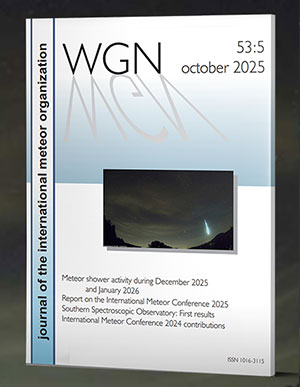Meteor activity picks up a bit during April as
two major showers are active during the month. The first of these, the Lyrids,
are active from the 16th through the 25th, with a pronounced maximum on the 22nd.
Unfortunately this date coincides with a full moon this year so activity will be
reduced. The Eta Aquarids start appearing near the 20th and reach maximum activity
during the first week in May. Sporadic rates are low but steady as seen from the
mid-northern hemisphere (45 N). Sporadic rates seen from the mid-southern hemisphere
(45 S) rise this month toward a maximum in July.
During this period the moon reaches its last
quarter phase on Monday April 28th. At this time the moon will be located ninety
degrees west of the sun and will rise near 0100 local daylight time (DST). During
this period the slow evening hours will be free of moonlight while the moon will
shine brightly during the morning hours. Successful meteor observations can be
undertaken if you observe with the moon at your back or toward the darkest portion
of the sky. Dry, transparent skies will help immensely as far less moonlight will
be scattered allowing fainter stars, thus fainter meteors to be seen. As seen from
the mid-northern hemisphere (45 N) the estimated
total hourly rates during the evening observers would be only one. For morning observers
the estimated total hourly rates should be near six. For those located in the
mid-southern hemisphere (45 S) morning rates would be near ten and evening
rates near two. These rates assume that you are watching from rural areas away
from all sources of light pollution. The actual rates will also depend on factors
such as personal light and motion perception, local weather conditions, alertness
and experience in watching meteor activity. Morning rates are reduced by moonlight.
The radiant positions and rates listed below are exact
for Saturday night/Sunday morning April 26/27. These positions do not change
greatly day to day so the listed coordinates may be used during this entire period.
Most star atlases (available at science stores and planetariums) will provide maps
with grid lines of the celestial coordinates so that you may find out exactly where
these positions are located in the sky. A planisphere or computer planetarium program
is also useful in showing the sky at any time of night on any date of the year.
Activity from each radiant is best seen when it is positioned highest in the sky,
either due north or south along the meridian, depending on your latitude. It must
be remembered that meteor activity is rarely seen at the radiant position. Rather
they shoot outwards from the radiant so it is best to center your field of view so
that the radiant lies at the edge and not the center. Viewing there will allow you to
easily trace the path of each meteor back to the radiant (if it is a shower member)
or in another direction if it is a sporadic. Meteor activity is not seen from radiants
that are located below the horizon. The positions below are listed in a west to east
manner in order of right ascension (celestial longitude). The positions listed first
are located further west therefore are accessible earlier in the night while those
listed further down the list rise later in the night.
The following showers are expected to be active this week:
The Pi Puppids (PPU) is a relatively new shower with most of the activity
occurring when the parent comet (26P Grigg-Skjellerup) is near perihelion. This
comet was at perihelion this past March but no activity of this shower has been
reported so far. The radiant for this shower lies far to the south and is nearly
impossible to detect north of thirty degrees north latitude. The radiant position
lies at 07:18 (110) -45. This area of the sky is located in southern Puppis, two
degrees southwest of the third magnitude star Sigma Puppis. The radiant lies
highest in a dark sky as soon as it becomes dark at the end of evening twilight.
Peak activity occurred on April 23, but a few shower members may be detected up to
April 28. With an entry velocity of only 18 kilometers per second, these
meteors will appear to move very slowly. Shower members are usually quite
bright which may also aid in their identification.
The large Antihelion (ANT) radiant is now centered at 15:16 (229) -18. This
area of the sky lies in central Libra, two degrees north of the faint star Iota
Librae. Actually any meteor from western Scorpius, eastern Hydra, as well as Libra
could be a candidate for this shower. This radiant is best placed near 0200 LDT
time when it lies on the meridian and is highest in the sky. Rates at this time
should be near one for northern observers and two for observers south of the equator.
With an entry velocity of 30 km/sec., the average Antihelion meteor would be of
medium-slow speed.
The Eta Aquariids (ETA) are particles from Halley’s Comet, produced in
Earth-crossing orbits many centuries ago. We pass closest to these orbits from
May 3 through the 7th. During this period the Eta Aquariids are at their best,
capable of producing ZHR’s of sixty. The actual visible rates are most often less
than half this figure due to the low altitude of the radiant at dawn. Observed
hourly rates at maximum normally vary from zero at 60 degrees north latitude to
25 near the equator and back down to near zero again in Antarctica, where the
radiant elevation is very low. Early in the activity period, as we are now, hourly
rates would vary from zero to two per hour depending on your latitude and observing
conditions. The radiant is currently located at 22:00 (330) -04. This area of the
sky is located in northern Aquarius, four degrees south of the third magnitude
star Sadalmelik (Alpha Aquarii). The best time to view this activity is just
before the start of morning twilight, when the radiant lies highest in a dark sky.
No matter your location these meteors will appear from the eastern sky and shoot
in all directions. If the radiant has sufficient altitude Eta Aquariid meteors can
also be seen shooting down toward the eastern horizon. With an entry velocity of
66 kilometers per second, a majority of these meteors will appear to move swiftly
with a high percentage of the bright meteors leaving persistent trains.
As seen from the mid-northern hemisphere (45N) the Sporadic rates are
low, but fairly steady. One would expect to see approximately four random meteors
during the last hour before dawn from rural observing sites and only one per hour
during the evening hours. As seen from the mid-southern hemisphere (45S) morning
rates would be near seven per hour as seen from rural observing sites and two
per hour during the evening hours. Morning rates are reduced due to moonlight.
The table below presents a condensed version of the expected activity this week.
Rates and positions are exact for Saturday night/Sunday morning.
| SHOWER | DATE OF MAXIMUM ACTIVITY | CELESTIAL POSITION | ENTRY VELOCITY | CULMINATION | HOURLY RATE | CLASS* | RA (RA in Deg.) DEC | Km/Sec | Local Daylight Time | North-South | Pi Puppids (PPU) | Apr 23 | 07:18 (110) -45 | 18 | 18:00 | 0 – <1 | II | Antihelion (ANT) | – | 15:16 (229) -18 | 30 | 02:00 | 1 – 2 | II | Eta Aquariid (ETA) | May 05 | 22:00 (330) -04 | 66 | 08:00 | 1 – 1 | II |




 You saw something bright and fast? Like a huge shooting star? Report it: it may be a fireball.
You saw something bright and fast? Like a huge shooting star? Report it: it may be a fireball.  You counted meteors last night? Share your results with us!
You counted meteors last night? Share your results with us!  You took a photo of a meteor or fireball? You have a screenshot of your cam? Share it with us!
You took a photo of a meteor or fireball? You have a screenshot of your cam? Share it with us!  You caught a meteor or fireball on video? Share your video with us!
You caught a meteor or fireball on video? Share your video with us!